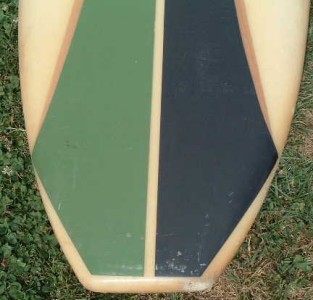 |
Stringerless
Common in many timber boards. Introduced by Midget Farrelly in foam boards 1965 for weight reduction. See # 110 |
 |
Three -Quarter
Unusual, notably used in the Featherlite model by Hansen Surfboards, USA circa 1967. See copied version See # 3 |
 |
Single
Standard foam blank addition |
 |
T - Band
One thick stringer laminated between two thinner stringers - the ' T' indicating a total of Three. See # 48 |
 |
Reverse T - Band
One thin stringer laminated between two thicker stringers - the ' T' indicating a total of Three. |
 |
Twin/Double
Unusual in surfboards but common in sailboard blanks to allow support for the mast-track and finbox inserts. |
 |
Multi
Two or more stringers See # 67 |
 |
Offset
Multi stringers, not parrallel to the centre line. See # 80 |
 |
Flared
A mostly straight stringer that curves out to the rail line at one end. |
 |
Curved |
 |
Detailed
Multi stringers that twist or cross. Extremely rare. See # 127 below. |
 |
Detailed stringers by John Rhodes/Tony Nicholas Sufboards, Cronulla NSW, circa 1966 |
 |
Inserts
Not real stringers but timber inserts added post production, usually to repair and strenghten broken/cracked boards. |
DEFINITIONS
stringer
timber beam inserted into a blank to add structural strength. Originally used in solid wood boards after WW I to maintain strength while incorporating lighter timbers such as balsa, see Pacific Homes Systems. With the introduction of fibreglass, stringers were not considered essential in an all balsa wood blank, but reappeared when foam blanks were developed, credited to Hobie Alter (USA),1957. The stringer added strength and also gave the shaper and the glasser/decorator a line of symmetry on the all white blank. Post-foam balsa boards adopted stringer use : multi-stringer placement can be used to balance the board and stringers are invariably attractive. See also glue line, T Band. stringerless
a (foam) blank without timber/resin reinforcement strip/s, usually for weight reduction,
originally developed by Midget Farrelly 1965. The lack of a centre line made shaping difficult and in the late 1960’s often a glueline was used as a compromise. Last application was in 1970 Popouts – some models had a knife cut down the centre of the blank that filled with resin during laminating to produce a faux glueline. Pre 1920 solid wood boards did not have stringers and pre 1960 fibreglassed balsa boards
were usually glueups of four or more blocks.
glue line a resin line joining sections of the blank as a lightweight alternative to a wood stringer. It alsousually serves to provide the shaper with a line of symmetry – contrast difficulties with a stringerless blank. Mostly used from about 1967 to 1972 for weight reduction.
T-band
1. wide three part (hence T) stringer, usually comprised of a wide soft stringer (balsa, spruce, high density foam) laminated between two thin redwood stringers. Also Reverse T Band, thin centre
between two thicker stringers.
2. a wood stringer and matching wood tail block, thus forming a ‘T’
- Kelly: Surf and Sea (1965).
Flared Stringers
A mostly straight stringer that curves out to the rail line at one end.

| Twin flared stringers circa 1965.
Surfboards by (Norm) Casey. Image contributed, with thanks, by Tim Clarkson, Victoria, January 2006. Tim reported... Length 9 ft 3'' x 20 1/2 inches My father in law says he got it second hand in 1967. He bought it of a workmate's mate in Camberwell Victoria. It already had a couple of dings and that the fin had already been replaced. Note that the 'stringers' are inlayed and do not extend through the blank. The bottom has a single straight centre 'stringer'. In detail image, right, the 'stringers' are taped and do not extend into the rail. |
 |

No hay comentarios:
Publicar un comentario